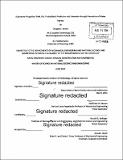Submarine propulsion shaft life : probabilistic prediction and extension through prevention of water ingress
Author(s)
Jonart, Douglas E. (Douglas Edward)
DownloadFull printable version (6.332Mb)
Other Contributors
Massachusetts Institute of Technology. Department of Materials Science and Engineering.
Advisor
Alexander H. Slocum and Ronald G. Ballinger.
Terms of use
Metadata
Show full item recordAbstract
Submarine propulsion shafts have demonstrated acceptable reliability performance when inspected and refurbished at least every 6 years. Designers wish to extend the inspection interval to 12 years without sacrificing reliability. This interval is unprecedented, as no known submarine shafting system is currently operated with this inspection cycle, nor are any known commercial vessel shafts. Experience and improved design have eliminated many threats to the life of a submarine shaft, but inspections of existing shafts show a high percentage with signs of wetting, leaving designers with less-than-acceptable confidence to approve this longer inspection interval due to the possibility of corrosion fatigue failure. This thesis uses probabilistic models from literature for pitting and cracking of wetted shafts, along with Monte Carlo simulations, to predict results of shafts inspections. Each possible water ingress distribution is analyzed by simulating shafts under 6 years of exposure to the water ingress, pitting, and cracking models in order to estimate the effects of corrosion fatigue. A water ingress distribution that predicts inspection results closest to actual inspection results is identified. Some information about water ingress is inferred from this distribution. Next, using the same literature models, a water ingress distribution that predicts similar performance at 12 years is identified. It is shown that the time a shaft is in service prior to becoming wetted must increase substantially. Predicted failure rates are low, but they are still higher than acceptable. This thesis recommends that inspection procedures are updated to provide more robust information for future analyses, which would better identify the appropriate distributions and greatly reduce uncertainty.
Description
Thesis: S.M., Massachusetts Institute of Technology, Department of Materials Science and Engineering, 2014. Thesis: M. Eng. in Naval Construction and Engineering, Massachusetts Institute of Technology, Department of Materials Science and Engineering, 2014. Cataloged from PDF version of thesis. "June 2014." Includes bibliographical references (pages 46-47).
Date issued
2014Department
Massachusetts Institute of Technology. Department of Materials Science and EngineeringPublisher
Massachusetts Institute of Technology
Keywords
Materials Science and Engineering.